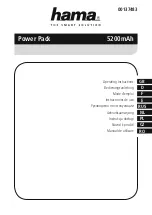
13
3-5
Setting the Pressure on the Pump
To set the pressure on the pump, follow this procedure:
1. Loosen the wing nut below the “T” handle on the pump’s external pressure regulator. Then turn the
“T” handle (shown below) counterclockwise (CCW) until it turns freely and easily.
2. Turn the pump “on”. Using the pump’s remote control pendant, push down the advance switch (or button on air
pumps) and hold it.
3. While holding the pump in the advance mode, slowly turn the “T” handle clockwise and observe the pump
pressure gauge rise.
NOTE: Always adjust the regulator pressure up - never down.
4. When your gauge reaches 4,000 PSI, stop turning the “T” handle and let the gauge settle out.
5. If the pressure continues to rise (above 4,000), release the advance button and back off your pressure slightly by
turning CCW on the “T” handle. Then re-depress the advance switch on your remote and slowly bring pressure
up to 4,000 again.
6. When the pressure is correct, turn the pump “off’ and tighten the wing nut provided under the “T” handle.
This sets pump pressure, which determines torque tool output.
7. Once your target pressure is set and locked, cycle the pump once more to ensure that your pressure setting did not
change as you turned down the wing nut.
3-6
Applying the Torque Machine - the Tightening Process
1. Having set your target pressure, cycle the tool three or four times to full pressure before putting it on the
application. Cycling the tool ensures that the system is operating properly and removes trapped air, if any.
2. Place the proper size impact socket on the square drive and secure properly with a locking ring and pin.
3. Place the tool and the socket on the nut, making sure that the socket has fully engaged the nut. Further ensure that
the drive retainer is engaged.
4. Make sure the reaction arm is firmly abutted against a stationary object (e.g. an adjacent nut, flange, equipment
housing etc.)
5. When positioning the wrench, make sure that the hose connections are well clear of any obstructions, and that all
body parts are safely out of harm’s way.
6. THEN, AND ONLY THEN, apply momentary pressure to the system to ensure proper tool placement. If it
doesn’t look or act right, stop and re-adjust the reaction arm.














































